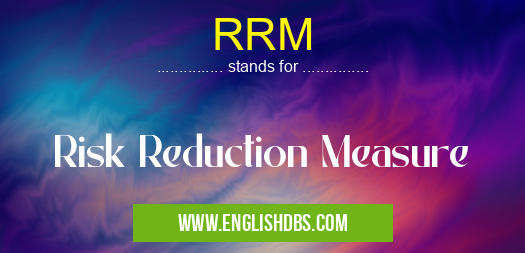What does RRM mean in UNCLASSIFIED
RRM stands for Risk Reduction Measure. It refers to actions taken to reduce the likelihood and/or impact of potential risks. RRMs are employed in various fields, including project management, safety engineering, and healthcare.

RRM meaning in Unclassified in Miscellaneous
RRM mostly used in an acronym Unclassified in Category Miscellaneous that means Risk Reduction Measure
Shorthand: RRM,
Full Form: Risk Reduction Measure
For more information of "Risk Reduction Measure", see the section below.
Importance of Risk Reduction Measures
RRMs are crucial because they help organizations and individuals mitigate risks that could jeopardize their objectives. By implementing RRMs, entities can:
- Minimize the likelihood of risks occurring: RRMs aim to remove or reduce the factors that could trigger risks.
- Reduce the impact of risks: Even if risks cannot be eliminated, RRMs can help lessen their consequences.
- Enhance resilience: RRMs bolster the ability of an organization or individual to withstand and recover from potential risks.
Types of Risk Reduction Measures
RRMs can take various forms, including:
- Preventive measures: Aim to eliminate or reduce the causes of risks.
- Mitigating measures: Designed to minimize the impact of risks that cannot be prevented.
- Contingency measures: Plans developed to respond to risks that do occur.
Essential Questions and Answers on Risk Reduction Measure in "MISCELLANEOUS»UNFILED"
What is a Risk Reduction Measure (RRM)?
An RRM is a strategy or action taken to reduce the probability or severity of a risk. RRMs can be implemented in various areas, including health, safety, and environmental protection.
Why are RRMs important?
RRMs are crucial because they help organizations and individuals mitigate risks and protect themselves from potential harm or losses. By implementing appropriate RRMs, risks can be minimized or eliminated, ensuring a safer and more secure environment.
What are some examples of RRMs?
RRMs can vary depending on the specific risk being addressed. Some common examples include:
- Using personal protective equipment (PPE) in hazardous work environments
- Installing smoke detectors and fire extinguishers in buildings
- Implementing vaccination programs to prevent disease outbreaks
- Conducting safety training for employees
- Developing emergency response plans for natural disasters
How do I identify and prioritize RRMs?
To effectively implement RRMs, it is important to conduct a risk assessment to identify and prioritize potential risks. This involves evaluating the likelihood and potential impact of each risk and determining the appropriate measures to mitigate them.
What are the benefits of implementing RRMs?
Implementing RRMs offers numerous benefits, including:
- Reduced risk of accidents, injuries, or illnesses
- Improved safety and health outcomes
- Reduced costs associated with risk incidents
- Enhanced productivity and efficiency
- Improved compliance with regulatory requirements
Final Words: RRM is a fundamental concept in risk management. By implementing RRMs, organizations and individuals can proactively manage risks, enhance resilience, and achieve their objectives more effectively. The types of RRMs employed will depend on the specific risks identified and the risk tolerance of the organization or individual.
RRM also stands for: |
|
| All stands for RRM |
